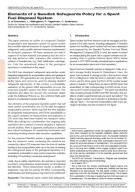Details
- Identification
- ISSN: 1977-5296, DOI: 10.3011/ESARDA.IJNSNP.2018.6
- Publication date
- 1 June 2018
- Author
- Joint Research Centre
Description
Volume: 56, June 2018, pages 36-42
Authors: G. af Ekenstam, L. Hildingsson, R. Fagerholm and C. Andersson
Section for Nuclear Non-proliferation and Security, Swedish Radiation Safety Authority
Abstract: This paper presents an outline of a proposed Swedish encapsulation and deposition system for spent nuclear fuel, possible national measures in support of international safeguards, and possible national measures implemented for domestic purposes. All these measures are only in support of nuclear material accountancy and are not in any way aimed at other scenarios that would be in violation of Swedish law, e.g., theft, falsification, sabotage, etc. Only the operational phase of the geological repository is considered in this paper.
The IAEA has developed safeguards approaches under integrated safeguards for encapsulation plants and geological repositories. The approaches are very generic for these two facility types and cannot be used for devising detailed safeguards approaches. In this context, a compatibility evaluation of the generic IAEA approaches vis-à-vis the proposed Swedish system has been conducted. This evaluation also takes into account the conclusion drawn under the Additional Protocol, i.e., the confirmed State-wide absence of undeclared nuclear activities.
Two elements of the proposed Swedish system that will need careful consideration are: (1) the high throughput encapsulation process–which may limit the time available for safeguards measurements; and (2) the unavailability of the copper canisters for measurement and evaluation of C/S once they have been loaded into transport casks. While also taking into consideration that ongoing daily operations over a period of several decades is expected at both facilities, there is apparent justification to develop very robust techniques for unattended verification and monitoring involving remote data transition capabilities.
For the proposed Swedish system, it appears imperative that the transport casks containing the canisters are covered by robust C/S measures from the time of canister loading at the encapsulation plant up to the time of entering the underground areas of the geological repository. It is considered undesirable to have routine inspection activities (including C/S activities) conducted underground.
Lastly, due to safety requirements, the operator is expected to perform comprehensive measurements on all individual fuel elements. These measurement results, in addition to equipment, may also be used by the IAEA. Consequently, authentication and sharing issues may need to be addressed.
Keywords: Final disposal; spent nuclear fuel; safeguards
Reference guideline:
af Ekenstam, G., Hildingsson, L., Fagerholm, R., & Andersson, C. (2018). Elements of a Swedish Safeguards Policy for a Spent Fuel Disposal System. ESARDA Bulletin - The International Journal of Nuclear Safeguards and Non-proliferation, 56, 36-42. https://doi.org/10.3011/ ESARDA.IJNSNP.2018.6

